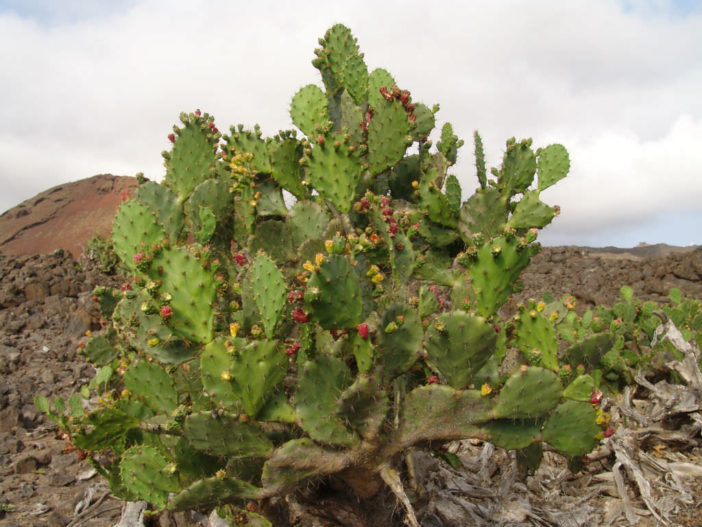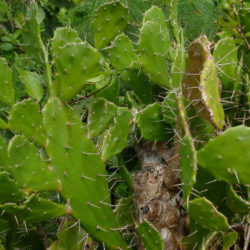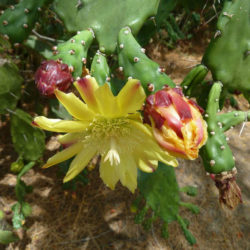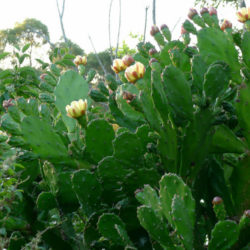Scientific Name
Opuntia monacantha (Willd.) Haw.
Common Name(s)
Barbary Fig, Cochineal Prickly Pear, Drooping Prickly Pear, Drooping Tree Pear, Spreading Prickly Pear
Synonym(s)
Cactus monacanthos
Opuntia vulgaris (synonym of Opuntia ficus-indica) has been misapplied to this species in Australia.
Scientific Classification
Family: Cactaceae
Subfamily: Opuntioideae
Tribe: Opuntieae
Genus: Opuntia
Description
Opuntia monacantha is a shrubby or tree-like cactus with a short trunk and glossy green stem segments with irregular margins and tapered towards the base. It can grow up to 20 feet (6 m) tall, with a trunk that reaches a diameter of 8 inches (20 cm). The stem segments are oblong, obovate, or lance-shaped and can be up to 12 inches (30 cm) long and 5 inches (12.5 cm) wide. The spines, mostly 1 or 2 per areole, are unequal, spreading in various directions, and mainly confined to the upper half of stem segments. They are white to brown with yellow or red markings, rarely all reddish, and up to 2 inches (5 cm) long. The glochids are yellowish to reddish brown.
The flowers are up to 3 inches (4.5 cm) in length and 4 inches (10 cm) in diameter and have outer tepals with red centers and yellow margins. The fruits are pear-shaped, green with red-purple shades, about 3 inches (7.5 cm) long and 2 inches (5 cm) in diameter.
Origin
Opuntia monacantha is native to Argentina, Uruguay, Paraguay, and Brazil and is naturalized in Australia and South Africa. It grows in subtropical or tropical moist lowland forests and sandy shores from sea level up to an altitude of 3,280 feet (1,000 m).

Hardiness
USDA hardiness zones 9a to 11b: from 20 °F (−6.7 °C) to 50 °F (+10 °C).
How to Grow and Care
Though the large variety of species within the Opuntia genus means different Prickly Pears may need slightly different care. All are desert cacti that need lots of sun, lots of light, and very little water. If you live in a hot, arid area, these plants can generally be planted outside, left alone, and enjoyed.
These cacti will grow just fine in a garden but can also be grown in pots. To repot, ensure the soil is dry, remove the pot, and remove the old soil. After treating any cuts with fungicide, place the cactus in a new pot and backfill it with potting soil. As with a new cutting, ensure not to water a newly repotting Prickly Pear briefly to avoid rotting its roots.
Opuntia can propagate either by cuttings or by seed. To propagate by cuttings, sever pads from a plant and let them dry to heal the wounds. Then place the plants in dry soil and refrain from watering them until they begin to grow to avoid rotting them.
See more at How to Grow and Care for Opuntia.
Forms
Links
- Back to genus Opuntia
- Succupedia: Browse succulents by Scientific Name, Common Name, Genus, Family, USDA Hardiness Zone, Origin, or cacti by Genus
Photo Gallery
Click on a photo to see a larger version.



